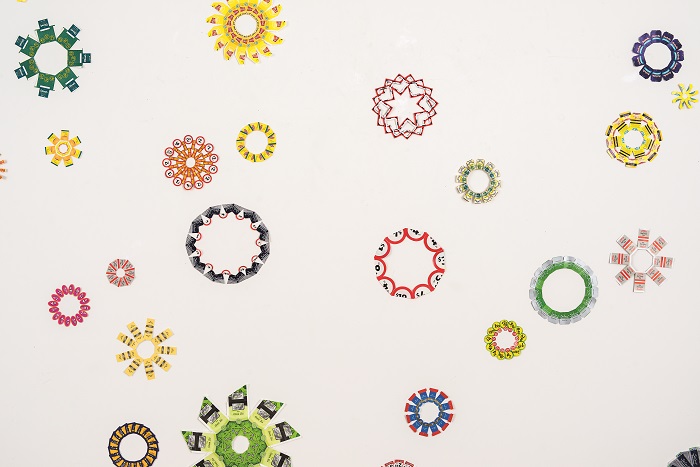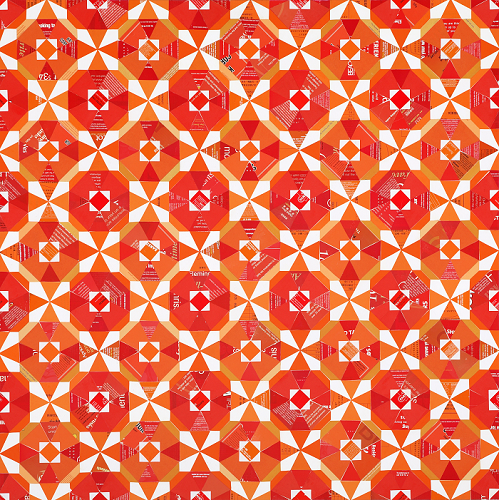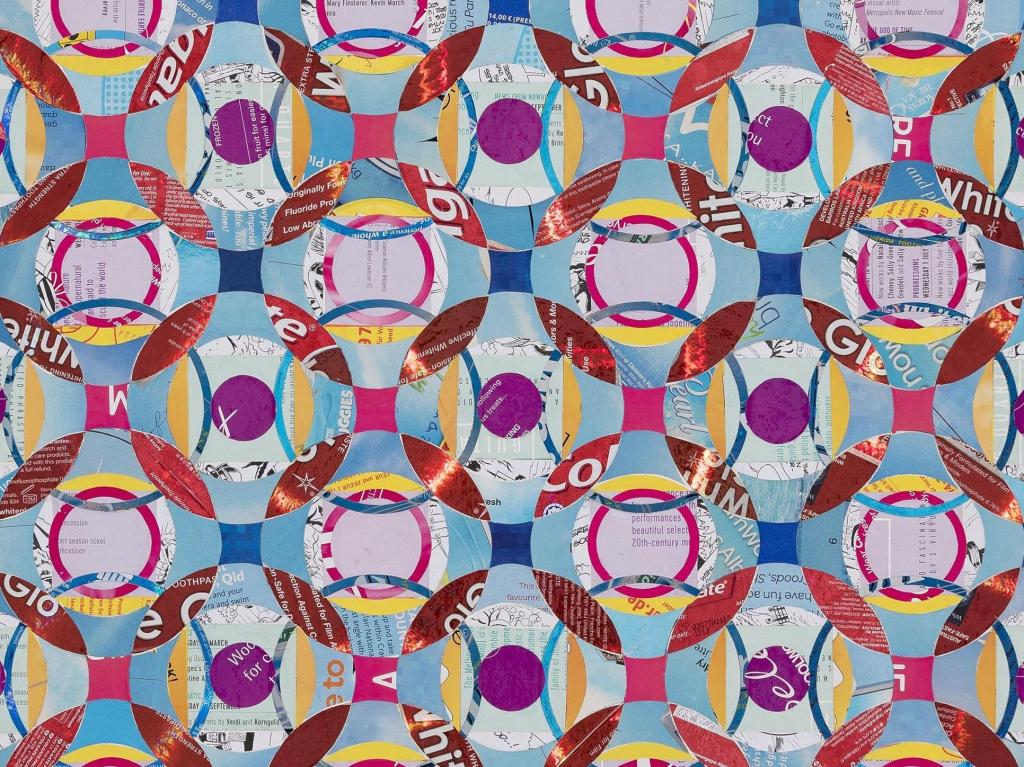Elizabeth Gower, Savings 2010–15, paper on board. Reproduced courtesy of the artist and Sutton Gallery, Melbourne.
As other artists might use paint as their medium, Elizabeth Gower uses paper; and as others might use a brush, she uses scissors. Her work might be called collage, but she prefers to use the term as an active verb: Elizabeth Gower collages. It is a process of collecting and reordering, of repurposing and reinventing.
The title of the exhibition, Cuttings, is exactly that, printed paper cut and fitted into shapes. Gower is an artist whose third eye sees in patterns. Derived from natural forms like stars and snowflakes and crystals, or mathematical sequences and geometries, her work has a characteristic playfulness that delights in design.
The appeal is immediate; its impact evident at the entrance to the two rooms that contain this collection of works dating from 1995 to the present. The site-specific work 365 Rotations adorns the wall like baubles on a Christmas tree or stars in a fantastical galaxy. The paper comes from food packaging labels, brochures, junk mail and tea bag tags, the ordinary things of everyday life that roll on and on day after day, hence the title, the 365 days of the year that are made up of little things in little moments. But presented here, the effect is kaleidoscopic and celebratory.
The ‘palette’ of paper might be made from throwaway things, but put together in the hands of an artist, it is far from trivial. Almost from the beginning of her career in 1975, Gower found her forms and themes. This exhibition is a guide to the different paths her art has taken, but never strays from the founding fundamentals of paper, scissors and glue, usually on drafting film.

150 Rotations (installation view, Melbourne Now, National Gallery of Victoria, 2013–14) 2013, food packaging, brochures, teabag tags, junk mail. Reproduced courtesy of the artist and Sutton Gallery, Melbourne. Photographer: Christian Markel, National Gallery of Victoria.
The command centre is the newest work, Monochrome Compilation, a 21-meter frieze that takes up an entire wall. It is unlike all the other work in its size and absence of colour, but its story is part of Gower’s ongoing interest in the attraction of consumption. The collage is a narrative that has edges but no middle, because the eyes are everywhere, beguiled by an ever-changing pattern of symbols and signals that flicker and flash on and off as we navigate the ephemera of our contemporary life. Here are reminders of test patterns, QR codes, pixels, news tickers, knitting patterns, tile designs and digital games. Step closer and the patterns become more fixed, step back and they oscillate. If this is a day in the life, it is hard to get a grip on any one thing for long. It is information overload. Gower is always looking to find order in an avalanche of advertising and messaging.
Monochrome Compilation is an update on the earlier works going back to Genera from 1995, which plays with printed advertising of shoes and couches and cars and guitars to create their own shape, their own identity, out of repetition of images from mass production. But behind the shapes is a secondary layer of negative space, where the invisible appears, creating a ghost double. These consumer objects are arranged to have a universe of their own.
As her career unfolds around the walls, Gower proves to be consistent in her practice but versatile in her influences. Variously we roam through coupons, catalogues, brochures and labels, but behind them are influences from Moorish tiles or quilt making, from knitting and weaving and dress patterns and floor coverings. The works have their origins in collage and découpage and scrapbooking, the domestic crafts, but here are transformed into art with something serious to say about the empty excesses of consumer culture and the weight of sustainability.

Prismatics 2006–07, paper on canvas. Reproduced courtesy of the artist and Sutton Gallery, Melbourne.
Photographer: Andrew Curtis.
When Gower graduated in the early ‘70s, women were absent from the pages of art history, other than as subjects. Her career has been a continuum of filling that vacuum, by deliberately taking the folk arts and crafts traditionally practised by women into the status of art by force of intellect and a supreme skill with scissors. She gives these things of seemingly secondary importance a second life, and a better life.
Elizabeth Gower’s work pays close attention. It is complex in design and intent. For that reason, the catalogue is a good buy. Between curator Lisa Sullivan’s introduction and Gower’s artist statements, viewers have in their hands the thematic history of the works, the references to the primary influences and the context of their creation.
Cuttings – Elizabeth Gower runs concurrently with the gallery’s showing of the 2018 Archibald Prize. From the eye-catching entrance, you can’t possibly miss it. And you shouldn’t. This is the work of an entirely original artist at the summit of her powers.
4 ½ stars ★★★★☆
Cuttings – Elizabeth Gower
Curator
Lisa Sullivan
1 September – 25 November, 2018
Geelong Gallery





